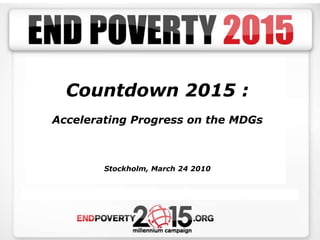Salil Shettys Mdg Presentation Stockholm March 2010
- 1. Countdown 2015 : Accelerating Progress on the MDGsStockholm, March 24 2010
- 2. MDGs – shared responsibilityMDGsDeveloped CountriesGOAL 8Developing CountriesIntegrate MDGs into policies, plans and budgets
- 3. Become accountable to citizens: human rights-based development
- 4. More aid and more effective aid
- 6. Increased poverty-focussed trade opportunities2000-2009 MDG Scorecard..…The single most durable set of global development commitments by governments – withstood 9/11 and its aftermathProvided a strong human development and poverty focus to all global processes – Monterrey, Paris, Accra, Doha, G8 and now G20Regional bodies embrace MDGs – AU, SAARC, Asean, EU Influenced national planning not only in most poor countries but also several middle income countries like Brazil and Indonesia Counterpoint to Washington consensus
- 7. 2000-9 MDG Scorecard….Over 35 countries have had their debts cancelled – big increase in poverty-focussed public expenditureAid levels have steadily increased – 30% higher than 1992 peak
- 8. MDG Outcomes have been very significantOver 400 million people come out of poverty since 2000 4 million fewer children die> 30 million more children in schoolHIV/AIDS, 30% reduction in new infections in 2008 compared to 1996, 2 m. receiving ARVsBig advances in TB, malaria, access to water63/117 countries on-track on malnutrition 30 more than in 2006Women MPs – 11% in 2000, 18% in 2009
- 10. MDG Progress - Poverty
- 11. MDG Progress - Education
- 12. MDG Progress – Child Health
- 13. Many of the poorest countries are on track on several GoalsOn most individual Goals, over 40 developing countries are on trackRwanda
- 14. Tanzania
- 15. Mali
- 16. Zambia
- 17. Mozambique
- 18. Ghana
- 19. Bangladesh
- 20. NepalSuccess: where it matters most!Ghana, Nicaragua cut hunger by half from 1991 to 2004Malnutrition rates cut from 22% to 6% in NE Brazil in less than ten years, Nigeria doubles production and income of farmers from 2001 to 2007Malawi goes from 43% food deficit in 2005 to 53% food surplus in 2007
- 21. Success: where it matters most!U5MR falls by >40% in Malawi, Mozambique, Eritrea, Ethiopia, Niger, Bangladesh, Nepal, Bolivia and LaosEthiopia puts 3 million more kids in school and Tanzania 2 million, doubling school enrollment from 2001 to 2006Honduras reduced MMR by 40% from 1990 to 2005
- 22. Why are these countries more on track?Leadership from the topGlobal MDGs adapted to National GoalsClear Plan, Policies & StrategiesMDGs prioritised in the allocation of domestic and external resources in the budgetHigh focus on improving delivery mechanisms for the poor
- 23. Why are some countries more on track?e. Greater accountability and transparency at all levels – more citizen engagementMore media and public debate International donors line up behind national priorities
- 24. Countdown 2015: the obstacle courseFinancial crisis – separating real impact from using this as an excuse Food and Climate crisis – more acuteGovernance and exclusion crisis – national and global; significant increase in inequalityTrade crisis – Doha impasse and new protectionismBig challenges in conflict zones, in MMR and sanitation
- 25. MDG Achievement – a matter of political choiceTotal amount given as bail outs in the last year is estimated at $18 trillion – cumulative aid in the last 49 years is less than $2 tr.Total spent on arms in 2008 $1.46 trillion – aid was about $120 billionResources lost through corruption by leaders of poor countries, often colluding with western governments and corporations, and mindless wars could have more than achieved MDGs
- 26. GrassrootsPolicy ChangeMedia/Public AwarenessCitizens action on MDGs needs a second wind to build political will
- 27. UN MDG Review Summit Sept 2010: Agreeing the 2010-15 Breakthrough Action PlanAccelerate progress based on what’s worked : This will motivate governments and people and create national ownershipMove the action to the local: Improve data and analysis at all levels – disaggregated, high frequency, and available in a simple form first to poor communities and local govtsGet serious about accountability: From local to national to global
- 28. UN MDG Review Summit: Web portal for civil societywww.un-ngls.org/mdg2010
- 29. Swedish civil society: Action AgendaLocal and national level actions in Sweden and EU: a. Build a strong public constituency of support for the MDGs b. Remind other EU Governments of their responsibility to keep their promises on aid, debt and trade - Goal 8; c. Create national momentum in the run up to the MDG Review SummitLocal, national and regional level actions in the South: a. Align programme design and impact at the local level towards the achievement of the MDGs, particularly for the poor; b. In all programmes, increase accountability of government to poor communities on the MDGs; c. Directly and through MDG Campaign Coalitions monitor MDG performance and reorient public expenditure towards MDGs.




















